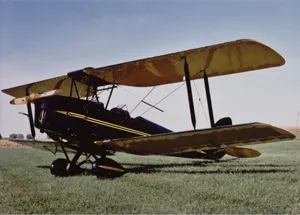
1941 deHavilland Tiger Moth
The Australian Tiger Moth was manufactured in Australia under the license of the deHavilland Company in England. This aircraft, a primary trainer during WWII, features an open cockpit, tandem seats, and lacks brakes, with a skid under the tail section. Constructed with wooden struts and exterior cables for tail section operation. The non-original wheel pants were custom-made during restoration.
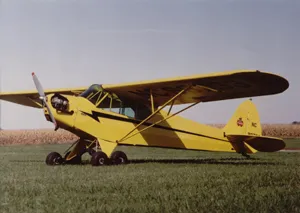
1946 Piper J-3 Cub
A classic American flyer, the Piper J-3 Cub, known for its simplicity and ease of flight, served diverse purposes. Widely used for pilot training, it also played roles in coyote and fox hunting, aerial surveying, and crop spraying. Originally equipped with a 65 horsepower Continental engine, it was later upgraded to 90 horsepower. The J-3 Cub boasts various sets of landing gear, including rough terrain tires, floats, and skis.
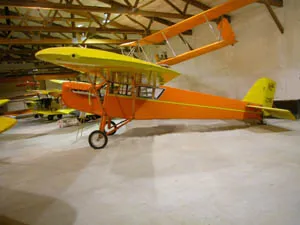
1928 Curtiss Robin
Donated to the museum in 1992 by Yvonne Schildberg in memory of her husband, this Curtiss Robin is the oldest known to exist. Built as the third one at the Curtiss Robinson Airplane Plant near St. Louis, Missouri, it features a 3-place cabin designed for two passengers, piloted from the front seat. The restoration process, lasting eight years, involved locating original parts. With a wingspan of 41 feet, it is a well-designed aircraft meant to reduce the surplus of OX-5 engines from WWI. It cruises at a slow 85 miles per hour and weighs 1450 pounds.
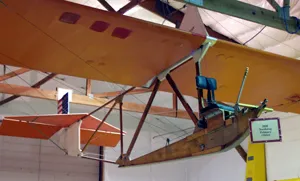
1929 Northrop Primary Glider
Constructed entirely of wood, this glider, featuring a metal control stick, was designed for rudimentary flying. Intended for young individuals, it required external assistance, often utilizing automobiles or horses for takeoff. The instructor would run alongside, providing instructions, and detach the glider when reaching a hill.

1937 Piper J-2
The Piper J-2, the inaugural airplane bearing the Piper name, gained prominence as the most successful light aircraft between WWI and WWII. Weighing only 660 pounds empty and 1000 pounds with fuel, oil, and occupants, it's a 2-place cabin piloted from the rear seat. Originally equipped with a 40 horsepower Continental engine, brakes were added for safety reasons in modern times. Piper discontinued J-2 production in 1937.
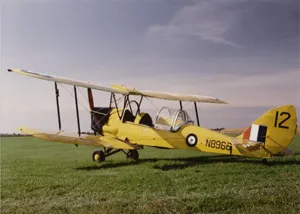
1941 deHavilland Tiger Moth, Canadian Model
Built in Canada under license, this Tiger Moth underwent modifications for Canadian weather conditions. Changes included a cockpit canopy, pins around the oil tank for an insulated blanket, and forward movement of the landing gear to prevent nose dumping in snow. Powered by a Gypsy Major 1C engine (130-140 horsepower), it served as a primary trainer in Canada.

1941 Aetna-Timm Aerocraft
Constructed in 1941 by Wally Timm of Glendale, California, this WWII trainer is the only remaining one of six built for a military contract competition. Equipped with a Kinner R55 engine (160 horsepower), it features 2-place tandem seats, with solo flights taken from the rear seat. The hydraulic brake system is cable-operated, and the aircraft is known for its excellent flying capabilities, ease of landing, takeoff, and aerobatics.

1946 Taylorcraft BC12
Donated by the family of Hall of Fame member "Bite" Livingston, this Taylorcraft boasts a side-by-side cabin and is steered with a wheel rather than a stick. Following C.G. Taylor's split with William Piper, Taylor started his own business in Alliance, Ohio. By 1940, Taylorcraft became the second-largest producer of light airplanes, with production peaking in 1946 at 30 new aircraft daily.
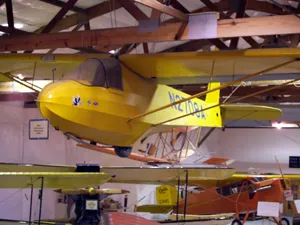
1957 Schweitzer Secondary Glider
This advanced glider features an enclosed cockpit and is towed by an airplane. While Schweitzer built the fuselage, struts, and tail section, the high-performance wings were designed by the company and built in the field by licensed mechanics. Only two such gliders were completed, and this particular one has flown over 800 hours, a notable achievement in glider history.
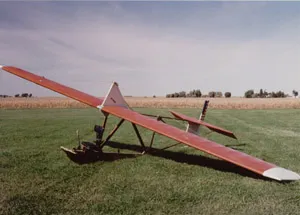
1932 Mead Primary Glider
Manufactured in Germany and sold in kit form in the United States in the early 1930s, the Mead Primary Glider was designed for slow gliding. Its wings, with large loops at the ends, and wheels under the ski were later additions to prevent damage when landing on hard surfaces in modern times.
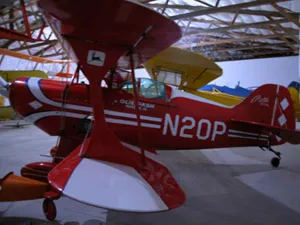
1968 Pitts Special S1S
Donated by Iowa's renowned aerobatic pilot, Olie Pash, after his retirement, the Pitts Special S1S is a tiny and nimble aircraft, favored for competition. Fully aerobatic, it can fly inverted as well as upright, with a wingspan of 17 feet 4 inches, length of 15 feet 6 inches, and a maximum speed of 185 mph.
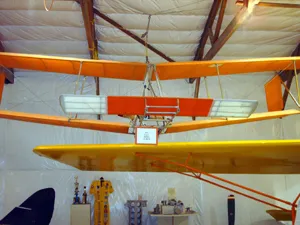
1975 Easy Riser Glider
One of the pioneering gliders to feature an engine at the back, the Easy Riser, powered by a 10 horsepower engine, is a forerunner of today's ultralights. This glider, gifted by Ernest Gruwell of Des Moines, marks a significant development in glider design.
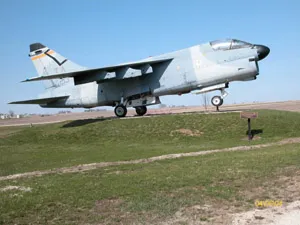
A-7D Corsair II
Flown by the Iowa Air National Guard from 1972-1992, the A-7D Corsair II was a lightweight attack carrier-based jet bomber. Capable of reaching speeds up to 685 mph, it was donated by the Iowa Air National Guard.
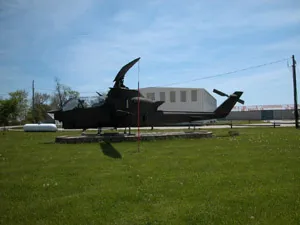
AH-1 Huey Cobra Gunship
Born out of necessity during the Vietnam War, the AH-1 Huey Cobra Gunship was designed to provide close air support for missions involving Huey transports and medivacs that often faced heavy ground fire. Donated by the Iowa National Guard, this model features an 1800 horsepower engine, reaching speeds up to 195 mph.
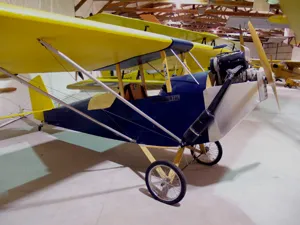
1929 Pietenpol Replica
A 7/8 scale ultralight Rag Wing, the Pietenpol Replica was built and donated by Eugene Jensen of Fontanelle, Iowa.

1931 Kari Keen
The 1931 Kari-Keen Coupe, built by Sioux Aircraft Corp., originally Kari-Keen, Inc. in Sioux City, Iowa, is one of only 32 built. Featuring a full cantilever wing, a 90 hp Warner radial engine, it was donated by Ralph Graham of Mendota Heights, MN.
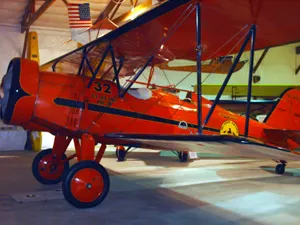
1929 Stearman
The first of 38 C3-R's designed by Lloyd Stearman, this aircraft flew mail, cargo, and passengers between Omaha, Sioux City, Huron, and the Twin Cities in the early 30s. Owned by Hanford Tri-States Airlines of Sioux City, it was gifted to the museum by Randy Graham and Lisa L. Graham-Peterson in memory of their father, Ralph Graham of Mendota Heights, MN.

1973 Evangel 4500
Awaiting restoration, the 1973 Evangel 4500 is one of only eight built in Orange City, Iowa (Serial #006). Initially used as a missionary aircraft for delivering cargo to remote areas, it was discovered abandoned on the island of Yap and donated by Jed Keck of Groesbeck, Texas.

Nieuport 17
A French Fighter Aircraft of WWI, the Nieuport 17 was used by the American Volunteer Pilots of the Lafayette Escadrille. Plans built to 7/8 scale (Replica) by Richard L. Milburn.
Ready to embark on a captivating journey through time and aviation mastery at our museum?
